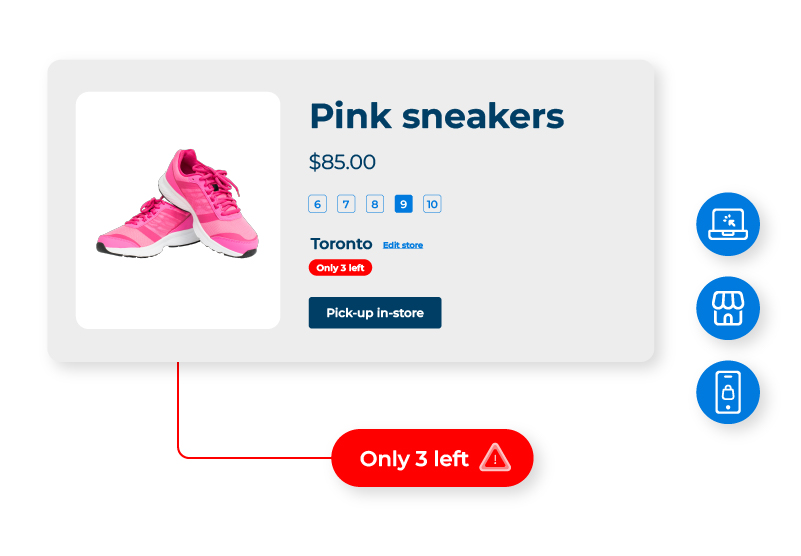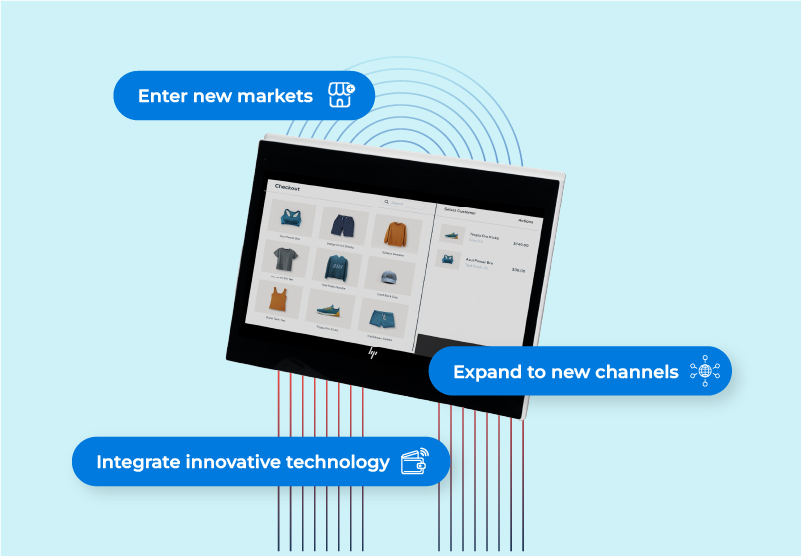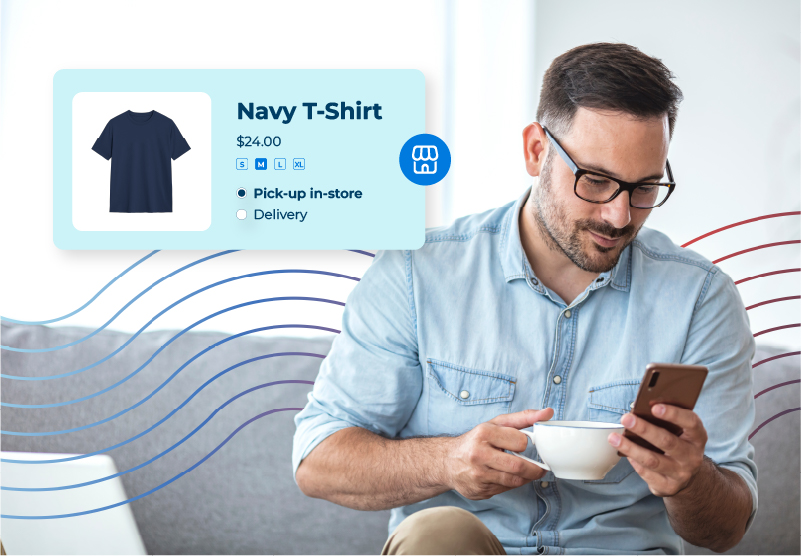Imagine browsing through a website for a pair of denim jeans and wondering if it’ll be best to try them on in the store before buying them. You head to the store and realize that those jeans don’t have the same discount as they did online. What a waste of time, energy, and fuel, right?
Shoppers expect uniformity in pricing and promotional offers across different touchpoints. 77% say they’re more likely to buy from brands that demonstrate consistency.
What is the solution to this problem? Omnichannel aka unified commerce. Let's dive deeper into the concept.
In this guide, we’ll cover the following:
- What is Omnichannel Commerce?
- What are the Components of Omnichannel Commerce?
- Benefits of Omnichannel POS systems
- Why opt for an Omnichannel POS for your business
- Conclusion
What is Omnichannel Commerce?
Omnichannel aka unified commerce offers a seamless, uninterrupted, and uniform purchasing experience across all channels and touchpoints, whether customers want to shop online, in-person at a retail store, or on a mobile device.
Omnichannel commerce combines all customer data collected under a single platform, ensuring all brand messaging, promotions, product imagery, and customer interactions are in tandem. This helps improve customer experience and strengthens their bond with the brand.
For instance, customers may browse products on a retailer's website but need to restart purchasing when they go to a physical store. In a unified commerce model, a customer could buy a shirt online and pick it up in-store. The inventory management system would automatically update the inventory levels in real-time. Alternatively, a customer could browse products in-store using a tablet and then complete their purchase online at home, with the same payment, promotions, and shipping options available.

What are the components of unified commerce?
There are four key components to unified commerce:1. Backend systems
Unified commerce brings together all customer-facing and backend systems on a single platform, making it easier for your business to grow and change. With a centralized system, you can avoid managing multiple providers, increase operational efficiency, and gain insights about your customers from different touchpoints. With unified commerce, you can easily enter new markets, expand to new channels, and integrate innovative technology, like digital wallets or kiosks, to scale your business across different channels and regions.2. Channels
Imagine a scenario where a customer purchases a pair of shoes online and then tries to return them in-store due to a defect; however, the staff have no record of the purchase and cannot provide any information on the warranty. This can lead to frustration for the customer, potentially leading to a negative experience and as a result they may be less likely to shop with that brand again in the future.
Omnichannel commerce makes payment processing simpler by combining payments from all channels onto a single platform. This helps you identify and connect customers across different channels and regions, making it easier to fulfill cross-channel purchases like click-and-collect or endless aisle options. For example, you can analyze how opening a new physical store impacts online sales in the same area or how a loyalty program in your mobile app affects in-store purchases.

3. Products
Omnichannel commerce provides customers with a consistent view of products across stores and online channels. For example, if your app or website indicates that only three pieces of the size nine pink sneakers are left in the store, the store staff should have the same knowledge of stock availability as the warehouse staff. This guarantees that clients get a consistent shopping experience and top-notch customer service whether they make their purchases online, in person, or on a mobile device.4. Customer interactions
Customers love a personalized experience because it makes them feel valued and appreciated, right? Personalization can also make the shopping experience more convenient and efficient, as customers are shown products and services relevant to their interests and preferences.
Omnichannel commerce streamlines the process of capturing and storing customer interactions in a secure and centralized manner. This makes it easier for businesses to understand customer preferences and behaviour and provide a personalized experience. This leads to quicker, more convenient interactions with the brand, such as the ability to check out with just one click and without repeatedly entering payment or shipping information when shopping from a particular brand again.

Benefits of Omnichannel POS systems
Improved Customer Experience
Omnichannel point-of-sale systems provide a consistent and seamless shopping experience across all channels. Whether customers shop online, in-store, or via a mobile app, they receive the same promotions, discounts, and services. This uniformity enhances customer satisfaction by ensuring that the shopping journey is smooth and predictable.
For instance, if a customer starts shopping online but chooses to pick up the item in-store, the process is streamlined and hassle-free. Such an integrated experience reduces frustration and builds trust, increasing customer loyalty and repeat business.
Enhanced Inventory Management
Omnichannel POS systems manage inventory in real-time across all sales channels. This real-time tracking prevents stockouts and overstock situations, ensuring that customers can always find what they are looking for. Accurate inventory management also enables better forecasting and planning.
For example, if a particular pair of jeans is selling faster online than in-store, the system can automatically adjust stock levels and reorder products to meet demand. This efficient management minimizes lost sales opportunities and reduces excess inventory costs.
Increased Sales and Revenue
Customers are more likely to complete a purchase when they can easily switch between channels and still receive the same level of service and pricing. Omnichannel POS systems support various sales strategies, such as buy online, pick up in-store (BOPIS), and endless aisle options, where customers can order out-of-stock items in-store for home delivery. These flexible purchasing options cater to customer preferences, driving higher conversion rates and average order values all the while maintaining a customer-centric approach to your business.
Streamlined Operations
Omnichannel POS systems integrate all sales channels into a single platform, simplifying operations and reducing the complexity of managing multiple systems. This integration enhances efficiency by centralizing data and processes, making it easier to manage orders, inventory, and customer information. As a result, businesses can reduce manual errors, save time, and lower operational costs.
For example, a single platform can automatically sync sales data from both online and offline channels, providing a unified view of business performance and streamlining accounting processes.
Better Data Insights
Omnichannel POS systems collect and consolidate data from all sales channels into one platform, providing businesses with valuable insights into customer behaviour, sales trends, and inventory levels. This comprehensive data can be analyzed to identify patterns and make informed business decisions.
For example, businesses can track which products are most popular during certain seasons or identify high-performing sales channels. These insights help optimize marketing strategies, improve inventory management, and enhance overall business strategy.
Enhanced Personalization
With a unified view of customer data, businesses can offer personalized experiences based on customer preferences and past behaviours. Omnichannel POS systems enable businesses to create targeted promotions, product recommendations, and marketing campaigns tailored to individual customers – a win-win for both customers and your business.
For instance, a customer who frequently purchases sportswear online might receive personalized offers on new arrivals in that category. This level of personalization increases customer engagement and loyalty, as customers feel valued and understood and in turn helps the likelihood of additional sales.
Why opt for an Omnichannel POS for your business
Adapt to Changing Consumer Behaviour
By adopting an omnichannel POS system, your business can meet these evolving expectations and stay competitive in the market. Customers can effortlessly transition from browsing on their mobile phones to purchasing in-store, enjoying a consistent experience throughout. This not only satisfies current customers but also attracts new ones who value convenience and consistency.
Future-Proof Your Business
Social media channels have gone beyond likes and comments. From Instagram shopping to TikTok shop, customers can now shop directly off social media platforms. As technology and consumer behaviours continue to evolve, an omnichannel POS system ensures that your business can adapt and remain relevant. It provides the flexibility to integrate new sales channels and technologies as they emerge, such as social media shopping and virtual reality experiences. By future-proofing your business with an omnichannel approach, you can reach your customers where they are, quickly respond to market changes and their preferences, maintaining a competitive edge.
Boost Customer Loyalty
A happy customer is a loyal one. A seamless and consistent shopping experience across all channels increases customer satisfaction and loyalty. Loyal customers are more likely to make repeat purchases and recommend your business to others. An omnichannel POS system helps build this loyalty by ensuring that customers can trust your brand to provide a reliable and enjoyable shopping experience every time, regardless of the channel they choose.
Optimize Resource Allocation
By consolidating all sales channels into a single platform, businesses can optimize their resources and reduce redundancies. This leads to cost savings and more efficient use of staff and technology. For example, a single inventory management system reduces the need for separate systems for each channel, streamlining operations and reducing IT costs. Staff can also be trained on one system rather than multiple, increasing efficiency and reducing training expenses.
Expand Market Reach
An omnichannel approach allows businesses to reach customers through multiple channels, increasing their market reach and potential customer base. This can lead to increased sales and growth opportunities. For example, customers who prefer shopping online can access your products just as easily as those who prefer visiting a physical store. By catering to diverse shopping preferences, you can attract a wider audience and expand your market presence.
Conclusion
A unified commerce approach is a customer-centric approach to retail that attempts to establish a holistic and consistent buying experience across all channels and touchpoints.
Your business can improve customer satisfaction, increase loyalty, and gain a deeper understanding of your customer's behaviour and preferences resulting in initiating a long-term relationship between the customer and your brand.
To explore an all-in-one unified commerce POS solution for your business, check out Moneris Total Commerce.
Share



